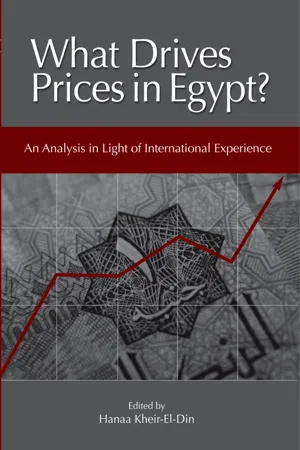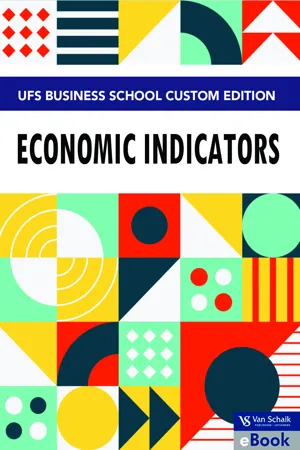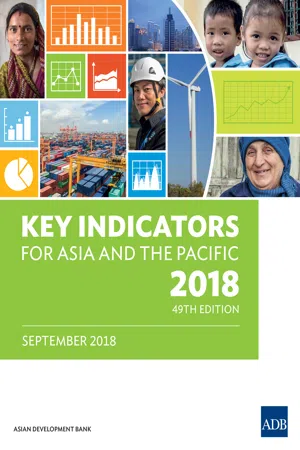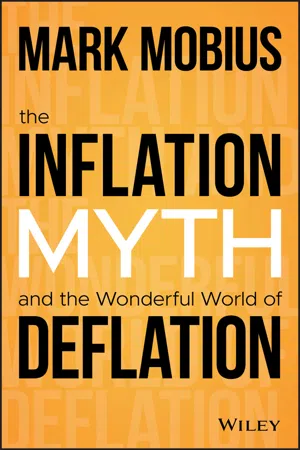Economics
Price Indices
Price indices are statistical measures used to track changes in the prices of goods and services over time. They provide a way to compare price levels at different points in time and are often used to calculate inflation rates. Common price indices include the Consumer Price Index (CPI) and the Producer Price Index (PPI), which are important tools for monitoring economic trends.
Written by Perlego with AI-assistance
Related key terms
Related key terms
1 of 4
Related key terms
1 of 3
7 Key excerpts on "Price Indices"
- eBook - ePub
What Drives Prices in Egypt?
An Analysis in Light of International Experience
- Hanaa Kheir-El-Din(Author)
- 2009(Publication Date)
- The American University in Cairo Press(Publisher)
The question then arises of how to measure this permanent increase (or more precisely, change) in prices. The answer is certainly: by using Price Indices that measure price changes in distinct periods. There is some convergence of views as to the ideal conceptual properties that would be possessed by a system of Price Indices designed for the analysis of inflation. These can be summarized as follows (ABS 1997):• It would encompass only market transactions, meaning that government services which are not marketed would not be included. • It would capture the current inflationary trend in prices associated with transactions in goods and services.4 • It would embrace the entire economy and not be restricted to particular segments. • It would provide a measure of pure price change (i.e., an increase in the price of all commodities without a change in relative prices). • It would be able to identify the effects of erratic price fluctuations. • It would be non-revisable and provide certainty to users. In practice, the fulfillment of this whole set of criteria is almost impossible. Therefore, each of the various Price Indices which have been developed to allow the measurement of inflation captures some but not all of the abovementioned properties. What really make the difference among various Price Indices are decisions concerning some aspects of the construction of the index. These aspects, which need to be clearly defined, include: what commodities or items should be included in the index; how to determine the prices of these items; which transactions involving these commodities should be included; and, finally, how to determine the weights and from which sources these weights should be drawn.Current versus Fixed Weight Price IndicesIn general, Price Indices could reflect current or fixed weights of the components of the index over time. The current weight Price Indices (CWPIs) combine various components of price changes using expenditure information for each period. In other words, this category of indices shows changes in expenditures between two periods of time when both the quantity of goods and services and prices are allowed to change. Differences in the value of the indices over time may reflect price and/or price and quantity changes. This feature can be an advantage for certain types of analysis, such as those for export and import prices where significant compositional change can occur over time and it is desirable to take into account prices that are actually paid or received in the current period rather than prices based on previous periods (ABS 1997). However, CWPIs are not considered a measure of ‘pure’ price change. - eBook - ePub
The Rise and Rise of Indicators
Their History and Geography
- Stephen Morse(Author)
- 2019(Publication Date)
- Routledge(Publisher)
2Economic indicesIntroduction
It is probably true that there are more indicators that revolve around money than any other area of human endeavour. I say ‘probably’ because one only has to look at the news each day to read about economic growth (or not, as the case may be), how businesses are doing, household income, house prices, inflation and so on. Almost all these stories include accompanying indicators by which the journalists and those being interviewed seek to tell us how well, or badly, matters are progressing. It can be bewildering to see how all of them use these measures to make their case and dismiss the case made by their opponents, who in turn seem to use much the same indicators to spin a completely different picture. The head can swim as you hear that the country is doing very well – ‘just look at indicator 1, indicator 2, etc.’ – only to be told by the next person who appears in front of us that the ‘country is in the doldrums as shown by indicator 3, indicator 4, etc.’ what makes it worse is that the same ‘thing’ seems to have a number of indicators. In the UK, for example, we have two ‘headline’ indices of inflation:- Consumer Price Index (CPI for short)
- Retail Price Index (RPI for short)
Both of them measure the change in prices of a ‘basket’ of goods and services over a period of time, and the index is expressed as a percentage: either a percentage increase or decrease. If inflation is positive (i.e. greater than zero) then the purchase power of money declines over time, meaning a pound buys less and less as its value declines. The CPI and RPI are, in essence, the averages of the change in price of the items in the basket, although part of this may well include an element of weighting to allow for the fact that a household may routinely purchase more of some goods (foods such as bread, for example) and services (such as water and power) than others (such as electronic goods). But why are there two measures? In fact, there are many measures of inflation, and, critically and obviously, much can depend upon what is included in the basket. As inflation gives us an idea how the purchase power of money changes over time, these measures are typically used by groups (pension companies, governments, service providers, trade unions, etc.) to estimate what they should be paid by customers, taxpayers, etc. for what they provide and also what payments (e.g. social security and pensions) should be made to households in order to maintain purchase power. But why have both the CPI and RPI? I am running the risk of oversimplification here given that there are variants of each, but the main difference between the CPI and RPI is that the CPI does not include the cost of accommodation (rent and mortgage payments, estate agent fees, etc.) while RPI does. Hence in the UK the CPI is often but not always lower than the RPI, and, perhaps unsurprisingly, those bodies that pay money to households (such as pensions and social security payments) tend to use the CPI, while bodies that require payment from households to government and private sector service providers often use the RPI. I suppose few have claimed that the world is fair! - eBook - ePub
- International Monetary Fund(Author)
- 1993(Publication Date)
- INTERNATIONAL MONETARY FUND(Publisher)
16.13. Unfortunately, it may sometimes happen, especially in the field of foreign trade statistics, that as a result of lack of information the data on which price and volume indices have to be calculated are not adequate for the purpose. For example, the basic information available may be limited to the total numbers of units of some group of products imported or exported, or their total weight: for example, the total numbers of pairs of shoes, or total weight of equipment of certain type. Indices built up from information of this kind are not volume indices when the numbers, or weights, cover different items selling at different prices. They are sometimes described as “quantity indices” for this reason. The “price” indices associated with such indices are usually described as average or “unit value” indices as they measure the change in the average value of units that are not homogeneous and may therefore be affected by changes in the mix of items as well as by changes in their prices. Unit value indices cannot therefore be expected to provide good measures of average price changes over time.Passage contains an image
C. Intertemporal index numbers of prices and volumes
1. Introduction
- 16.14. A price index is an average of the proportionate changes in the prices of a specified set of goods and services between two periods of time. Similarly, a volume index is an average of proportionate changes in the quantities of a specified set of goods and services. As already emphasized, the price and quantity changes refer to individual goods or services as distinct from groups of similar products. Different qualities of the same kind of product must be treated as separate goods or services in this context.
- 16.15. In line with normal conventions, the period that serves as the reference point will be designated as period o and the period which is compared with it designated as period t . The two periods may be consecutive or be separated by intervening periods. The ratio of the price, or quantity, of a specific product in period t to the price, or quantity, of the same product in period o, is described as a price relative, or quantity relative: namely,pt/poorqt/qo. Price and quantity relatives are pure numbers that are independent of the units in which the quantities are measured and the prices are quoted. Most index numbers can be expressed as, or derived from, weighted averages of these price or quantity relatives, the various formulas differing from each other mainly in the weights which they attach to the individual price or quantity relatives and the particular form of averages used—arithmetic, geometric, harmonic, etc.
2. Laspeyres and Paasche indices
- 16.16. The two most commonly used indices are the Laspeyres and Paasche indices. Both may be defined as weighted averages of price or quantity relatives, the weights being the values of the individual goods or services in one or other of the two periods being compared.
- eBook - ePub
- P Mohr, D Yu, S Adendorff(Authors)
- 2020(Publication Date)
- Van Schaik Publishers(Publisher)
The general price level, however, is not directly observable. The quantities of goods and services are expressed in a variety of physical units (eg tonne, kilogram, 100 litre, metre, watt, carat) and their prices are often not directly comparable. Some way therefore has to be found to combine the prices of a wide variety of goods and services into a single number. The solution is to use index numbers and to construct a price index. The topic of index numbers is wide-ranging and in this section we confine ourselves to those aspects that are required for an understanding of the compilation and interpretation of general or composite Price Indices. 1 An index number indicates the level of a single or composite variable in relation to its level at another time, during another period, at another place and so on. The most significant economic changes are those occurring over time. For our purposes, therefore, an index number can be defined as the ratio between the value of a variable or group of variables at a given time or during a specified period and its value at a base time or during a base period, the latter being normally set at 100. For example, if a loaf of bread costs R12,00 in 2016, the base period of the comparison, and R15,00 in 2017, the index number for 2017 is calculated as R 15, 00 R 12, 00 × 100 = 125 It is immediately apparent from the index number of 125 that the price of a loaf of bread increased by 25% from 2016 (the base period) to 2017. Likewise, if 2016 is the base period of an index and the index number for 2018 is 135, it is immediately apparent that the value of the variable or group of variables concerned increased by 35% between 2016 and 2018. An index is a series of index numbers with a fixed frequency (eg month, quarter, year). A specific index, such as the index of maize production, contains a single component (or variable) - eBook - ePub
- (Author)
- 2018(Publication Date)
- Asian Development Bank(Publisher)
Relative level of the aggregate volume of agricultural production for each year in comparison with the base period. It is based on the sum of price-weighted quantities of different agricultural commodities produced after deductions of quantities used as seed and feed weighted in a similar manner. The resulting aggregate therefore represents disposable production for any use, except as seed and feed. Manufacturing Production Index An index covering production in manufacturing. The exact coverage, the weighting system, and the methods of calculation vary from country to country, but the divergences are less important than, for example, in the case of price and wage indexes. MONEY, FINANCE, AND PRICES Prices Consumer Price Index An index that measures changes in prices against a reference period of a basket of goods and services purchased by households. Based on the purpose of the consumer price index, different baskets of goods and services can be selected. For macroeconomic purposes, a broad-based basket is used to represent the relative price movement of household final consumption expenditure. Food Consumer Price Index An index that measures the change over time in the general level of prices of food and nonalcoholic beverage items that households acquire, pay for, or use for consumption. This is done by measuring the cost of purchasing a fixed basket of consumer food and beverages of constant quality and similar characteristics, with the products in the basket being selected to be representative of households’ expenditure during a specified period. Nonfood Consumer Price Index An index that measures the change over time, in general level, of the prices of nonfood items that household acquire, pay for, or use for consumption. The nonfood index includes items such as clothing, housing and repairs, water, electricity, fuel, services, and miscellaneous goods, or all items in the basket of goods and services other than food and nonalcoholic beverages. - eBook - ePub
- International Monetary Fund(Author)
- 2009(Publication Date)
- INTERNATIONAL MONETARY FUND(Publisher)
15.105 For some products, for example closely specified agricultural products or minerals, it may be that the current value data have been constructed by multiplying a volume measure by an appropriate price. These are instances when there is no aggregation problem across the group of products and adjustments for quality differences are more easily and more satisfactorily made to the volume measures directly. While some such products may be of significant value in some countries, it will be a small number of the total number of products that can best be treated in this way.15.106 To obtain a Laspeyres volume measure the appropriate price index used to deflate the current value is a Paasche index and vice versa. However, the available Price Indices are nearly always constructed using the Laspeyres or Lowe formulae, because construction of a Paasche price index has exactly the same data requirements as the direct derivation of a Laspeyres volume index and faces the same problems. If robust current value data and Laspeyres Price Indices are available at a sufficiently detailed level then Paasche volume indices, at the detailed level, can be aggregated using the Laspeyres formula to obtain an approximation of a true Laspeyres volume measure of the aggregate.15.107 A Fisher volume index can be obtained either by taking the geometric mean of Laspeyres and Paasche volume indices or by deflating an index of the current values by a Fisher price index.2. Available Price Indices
15.108 There are four major types of price index available to derive volume measures in the national accounts: consumer Price Indices (CPIs), producer Price Indices (PPIs), export Price Indices (XPIs) and import Price Indices (MPIs). CPIs are measures of purchasers’ prices and PPIs are measures of basic prices. XPIs are measures of FOB prices; MPIs may measure FOB or CIF prices.15.109 There are two defining aspects of recording transactions: timing and valuation. It is therefore critical that the Price Indices and the current values they are used to deflate correspond in both these aspects, as well as scope. The four types of Price Indices are usually available monthly and so quarterly and annual deflators can be obtained for flow and stock variables by averaging the monthly indices appropriately to centre the average at the desired valuation point. For flow variables this is usually the mid-point of the period, while for stock variables it is usually, but not always, the end of the period. For flow variables, the average price of the period should reflect known variations within the period. This is particularly important when there is a strong seasonal pattern, large irregular movements in certain months or hyperinflation. When none of these factors is present, the average price will be close to the observed price at the middle of the time period. The fact that this is frequently the case does not imply that the mid-period price is always the conceptually correct one to take, however. - Mark Mobius(Author)
- 2020(Publication Date)
- Wiley(Publisher)
Having worked out what should be in the basket of goods to accurately reflect consumer behavior, the second step was to calculate the value of that basket regularly, on a monthly basis. The Index altered each month based on the changes in the prices of the representative items. If the value of all the index items increases by 10%, then the inflation rate will be 10%. The basic fault of the system was the changing components of the index, with index components being changed on the basis of consumer surveys – which themselves were subject to error.Building the Index
As of the early 2000s, the US used a CPI measurement system which started with the construction of a “market basket” of goods and services for the “typical” consumer in the economy. The research included thousands of items divided into hundreds of categories of consumer products or services under major groups: food, housing, apparel, transportation, medical care, recreation, education and communication, and “other.” The basket of items would be adjusted every few years according to changes in the purchasing patterns of families.The Bureau of Labor Statistics researchers interviewed families all over America to find out what the families actually purchased, so the specific items purchased the most could be included in the Index. In addition to the survey, families were asked to keep diaries of their spending habits. The prices included in the basket and the significance of the different price changes depended on how much of the various goods and services house‐holds bought. A product or service that was consumed on a large scale was given greater weight than one that was consumed on a lesser scale. This meant that price changes on a product or service that was consumed on a large scale had a greater impact on the CPI than price changes on a product or service consumed on a lesser scale. The next step in the process was to determine the price of each item in the basket regularly, mostly monthly, and then calculate the value of the entire basket – of course taking into account the different weights of each good and service. If the value of the entire basket rose by 10% then the CPI inflation rate would be 10%.
Index pages curate the most relevant extracts from our library of academic textbooks. They’ve been created using an in-house natural language model (NLM), each adding context and meaning to key research topics.
Explore more topic indexes
Explore more topic indexes
1 of 6
Explore more topic indexes
1 of 4






